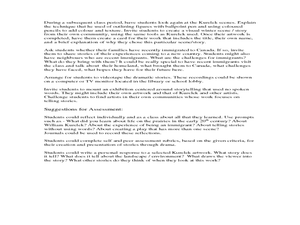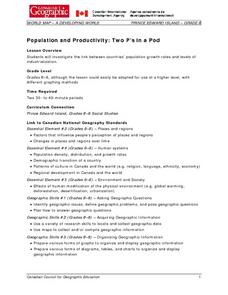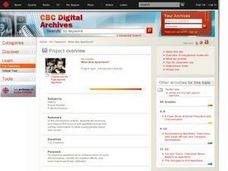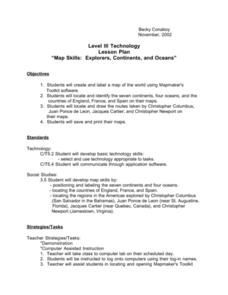Curated OER
Mapping the changes in Canada's population
High schoolers find and analyze data found in the census. They compare the population from 1996 to 2001. They explore the type of data they can find in the Census of Population.
Curated OER
Successful Resource-based Learning Strategies for the Geography of Canada Course
Students conduct a statistical research project on population changes. They evaluate demographic issues, such as the size and location of native people. immigrant groups, and the age and gender of the population.
Curated OER
Route Map Lesson Plan
Students read and make a route map by following step by step directions. They identify and make legends.
Curated OER
Stories of Life in Canada
Students examine Canadian history through William Kurelek's artwork. In this art analysis lesson plan, students discuss the ideas expressed in the picture book A Prairie Boy's Winter and A Prairie Boy's Summer. Students view the film...
Curated OER
Rushing the Border
Students discuss the issues of immigrants who overstay their legal welcome. They explore the recent changes in immigration registration, and participate in a roundtable discussion.
Curated OER
A Day in the Life of Bill C-One
Students explore the procedures that make bills into laws, identify the sources of opinion that form debates, bills, and laws and engage in part of the process by discussing whether or not a bill should become a law.
Curated OER
Internet Shopping Business Idea
Students create their own Internet business based on data they find concerning trends in Internet shopping. They discuss advantages and disadvantages to selling specific products and/or services over the Internet.
Curated OER
Comparing the Health and Lifestyles of 13 Year-olds Around the World.
Eighth graders examine international data and statistics to evaluate the health and trends of 13 year old students around the world.
Curated OER
Population and Productivity: Two P's in a Pod
Students investigate the link between countries' population growth rates and levels of industrialization. They observe that, over time, as a country becomes more industrialized, its population growth rate decreases.
Curated OER
Thinking About our Rights and Freedoms
Students explain when and why the Canadian Charter of Rights and Freedoms became law, list two important rights or freedoms contained in the Charter and apply the law given in the handouts to the facts of the story to arrive at two...
Curated OER
Did Jack break the law?:
Learners identify the process for settling a legal dispute, identify key players in a legal dispute (who presents the facts; who makes the final decision) and determine what makes a decision fair.
Curated OER
That's MY Pencil: Simplified Mock Trial
Learners identify the process for settling a legal dispute, identify key players in a legal dispute (who presents the facts; who makes the final decision), and determine what makes a decision fair.
Curated OER
Thinking About Violence: Sexual Assault
Young scholars explain how the law defines a sexual assault, explain how the law views "consent" in a sexual encounter, extract a list of relevant facts from two stories and decide if the female has consented to sexual activity given the...
Curated OER
The Case of the Plugged Toilets:
Students identify the process for settling a criminal dispute (how are the facts of the case presented; how is the dispute resolved?, and
National First Ladies' Library
Where's Amelia?
Learners examine the life and accomplishments of Amelia Earhart and her status as a role model for women. After researching Earhart, they select another person they think is courageous and write a dialog between the two heroes as if they...
Curated OER
Landmarks of the Underground Railroad
Students explore the impact of the Underground Railroad. In this slavery lesson, students read slave accounts and discuss the details of the Fugitive Slave Law of 1850. Students consider the impact of anti-slavery efforts in Boston and...
Curated OER
What Was Apartheid?
Students research and discuss the former system of Apartheid in South Africa and focus on worldwide anti-Apartheid movements. They identify anti-Apartheid songs and present the lyrics to the class.
Curated OER
Map Skills: Explorers, Continents, and Oceans
Third graders use a software program to make and label a map of the world. On the map, they locate the seven continents, oceans and the countries of Europe. They also draw the routes of Christopher Columbus, Juan Ponce de Leon and...
Curated OER
Building the CPR
Tenth graders identify and clarify a problem, an issue, or an inquiry.They plan and conduct library and community research using primary and secondary print and non-print sources, including electronic sources. Students generate and...
Curated OER
Northern Neighbors
Fourth graders research a province in Canada in order to compare and contrast Canada to our country. They create a HyperStudio production to display their findings.
Curated OER
Female Fur Traders: Breaking Arbitrary Barriers
Eighth graders read a variety of articles and watch a video about the history of female Canadian fur traders. They contribute to a website on the subject and develop a presentation with their research for the class.
Curated OER
History of Film: Creating Heritage Moments
Fifth graders, in groups, research a specified topic of Canadian history. They dramatize their findings, become familiar with many filming techniques and film themselves in a historical skit for presentation to the class.
Curated OER
Growth of a Nation: Trading Cards
Students research and write about events and people that have contributed to the development of Canada. They develop their paragraphing skills and create a package of 10 Canadian History Trading Cards.
Curated OER
First Nations: Analysing Sources
Ninth graders examine the lifestyle and culture of First Nations people. They investigate and analyze primary and secondary source documents.
























